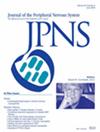Effect of age on metabolomic changes in a model of paclitaxel-induced peripheral neurotoxicity
Abstract
Background and Aims
Chemotherapy-induced peripheral neurotoxicity (CIPN) is one of the most common dose-limiting side effects of paclitaxel (PTX) treatment. Many age-related changes have been hypothesized to underlie susceptibility to damage or impaired regeneration/repair after nerve injury. The results of these studies, however, are inconclusive and other potential biomarkers of nerve impairment need to be investigated.
Methods
Twenty-four young (2 months) and 24 adult (9 months) Wistar male rats were randomized to either PTX treatment (10 mg/kg i.v. once/week for 4 weeks) or vehicle administration. Neurophysiological and behavioral tests were performed at baseline, after 4 weeks of treatment and 2-week follow-up. Skin biopsies and nerve specimens collected from sacrificed animals were examined for intraepidermal nerve fiber (IENF) density assessment and nerve morphology/morphometry. Blood and liver samples were collected for targeted metabolomics analysis.
Results
At the end of treatment, the neurophysiological studies revealed a reduction in sensory nerve action potential amplitude (p < .05) in the caudal nerve of young PTX-animals, and in both the digital and caudal nerve of adult PTX-animals (p < .05). A significant decrease in the mechanical threshold was observed only in young PTX-animals (p < .001), but not in adult PTX-ones. Nevertheless, both young and adult PTX-rats had reduced IENF density (p < .0001), which persisted at the end of follow-up period. Targeted metabolomics analysis showed significant differences in the plasma metabolite profiles between PTX-animals developing peripheral neuropathy and age-matched controls, with triglycerides, diglycerides, acylcarnitines, carnosine, long chain ceramides, sphingolipids, and bile acids playing a major role in the response to PTX administration.
Interpretation
Our study identifies for the first time multiple related metabolic axes involved in PTX-induced peripheral neurotoxicity, and suggests age-related differences in CIPN manifestations and in the metabolic profile.

 求助内容:
求助内容: 应助结果提醒方式:
应助结果提醒方式:


